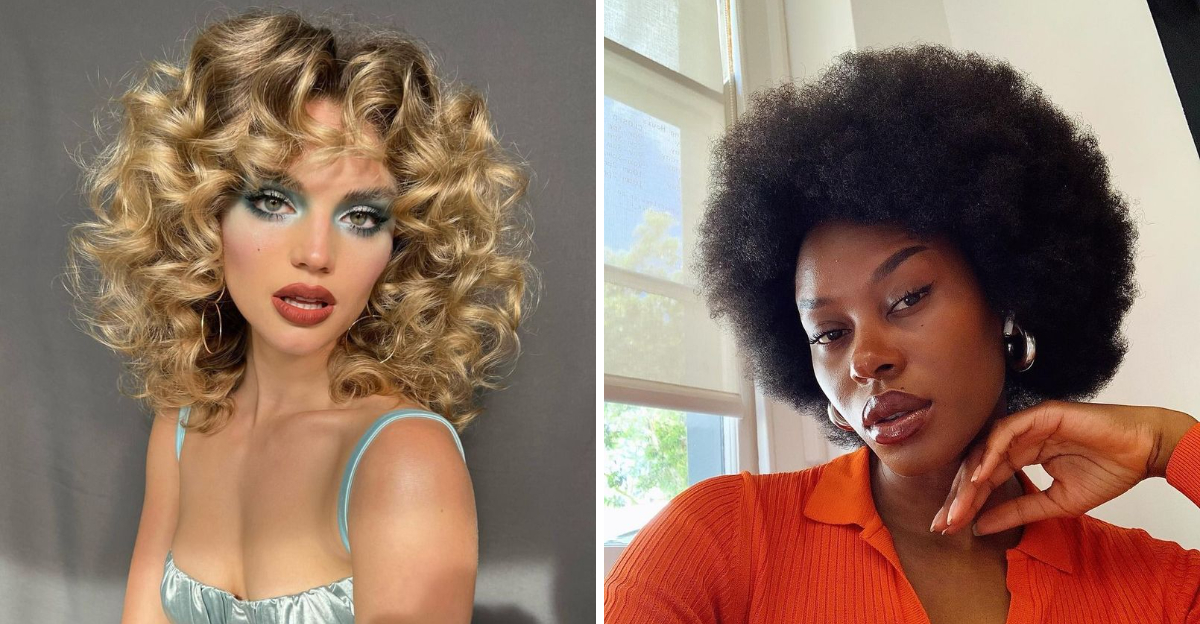Explore the evolution of hairstyles from 1970 to 2010, reflecting cultural and fashion trends of each year. This journey highlights one iconic hairstyle per year, capturing the essence of changing styles and personal expression. Uncover the history behind these popular trends.
1. 1970 – The Shag
The shag, with its layered cut and feathered edges, became a revolutionary look in 1970. This hairstyle was characterized by its carefree, tousled appearance, perfect for those looking to express a sense of freedom and rebellion.
2. 1971 – The Afro
Celebrating natural texture, the Afro became the symbol of black pride in 1971. Its voluminous, rounded shape allowed individuals to embrace their heritage and make bold fashion statements.
3. 1972 – The Feathered Flip
The feathered flip became a popular style in 1972, characterized by its sleek, face-framing layers with turned-out ends. This glamorous look was ideal for those seeking elegance and sophistication.
4. 1973 – The Long Hippie Waves
Long, loose waves epitomized the bohemian spirit of the early 1970s. In 1973, this style became synonymous with the hippie movement, symbolizing a laid-back lifestyle and a connection with nature and freedom.
5. 1974 – The Pageboy
The pageboy was a sleek, structured haircut popular in 1974. With its straight, rounded edges and classic silhouette, it offered a polished yet playful look, drawing inspiration from 1960s mod fashion.
6. 1975 – The Farrah Fawcett Waves
Inspired by Farrah Fawcett, this voluminous, layered style took 1975 by storm. With its iconic, bouncy waves, it became a symbol of glamour and femininity.
7. 1976 – The Punk Mohawk
The punk mohawk emerged as a bold, rebellious statement in 1976. Characterized by its shaved sides and spiky center, this hairstyle was emblematic of the punk rock movement, defying norms and embracing individuality.
8. 1977 – The Dorothy Hamill Wedge
The wedge, popularized by figure skater Dorothy Hamill, became a sensation in 1977. Its short, angular layers offered a fresh, dynamic look, combining practicality with style.
9. 1978 – The Disco Curls
The disco curls of 1978 brought high-energy style to the dance floor. With their vibrant, bouncy ringlets, this look complemented the era’s lively music scene.
10. 1979 – The Bowl Cut
The bowl cut, known for its even, rounded shape and short fringe, became a quirky trend in 1979. This geometric style offered a unique, playful look, appealing to those with a taste for unconventional fashion.
11. 1980 – The Perm
The perm, with its tight, spiral curls, reigned supreme in 1980. This bold hairstyle provided volume and texture, allowing individuals to make a dramatic statement and embrace the era’s love.
12. 1981 – The Mullet
The mullet, “business in the front, party in the back,” gained prominence in 1981. This versatile, edgy style became iconic for its contrasting lengths, appealing to those seeking both functionality and flair in their hair.
13. 1982 – The Side Ponytail
The side ponytail, often tied with a vibrant scrunchie, became a fun, youthful trend in 1982. This playful style added a touch of whimsy and energy, making it a favorite for those looking to embrace their youthful spirit.
14. 1983 – The Jheri Curl
The Jheri curl, with its glossy, loose curls, became a defining look of 1983. This style offered a relaxed yet polished appearance, providing a carefree look that was both manageable and stylish.
15. 1984 – The Crimped Hair
Crimped hair, with its distinctive zigzag texture, became a standout style in 1984. This quirky, eye-catching look added volume and flair, excellent for those wanting to make a bold, adventurous statement with their hair.
16. 1985 – The New Wave
The new wave hairstyle of 1985 featured asymmetrical cuts and vibrant highlights. Embracing a futuristic and avant-garde look, this style was perfect for individuals seeking to break away from traditional styles.
17. 1986 – The Big Hair
Big hair, with its voluminous curls, defined the glamor of 1986. This larger-than-life style epitomized the decade’s love for excess and drama, appealing to those wanting to make a grand, unforgettable entrance.
18. 1987 – The Rat Tail
The rat tail, a short cut with a singular long tail at the nape, became an eccentric trend in 1987. This quirky style offered a unique twist, appealing to those unafraid to express individuality in a subtle yet distinct manner.
19. 1988 – The Buzz Cut
The buzz cut emerged as a minimalist, practical choice in 1988. This close-cropped style was favored for its low maintenance and clean appearance, ideal for those seeking simplicity and effortless cool in their everyday look.
20. 1989 – The Flat Top
The flat top, with its high, squared-off shape, became a defining look of 1989. This structured style was particularly popular in hip-hop culture, offering a unique blend of creativity and precision.
21. 1990 – The Rachel
Inspired by Jennifer Aniston’s character on ‘Friends,’ “The Rachel” became a phenomenon in the 1990s. This layered, bouncy style was both chic and versatile, making it a popular choice for women seeking a modern, fashionable look.
22. 1991 – The High Top Fade
The high top fade, characterized by its tall, flat shape, became a defining look in 1991. Its bold, geometric structure made it a favorite among those wanting to showcase individuality and creativity.
23. 1992 – The Curtained Hair
Curtained hair, with its middle part and relaxed flow, became a popular trend in 1992. This style, often associated with boy bands and heartthrobs, offered a laid-back, approachable look.
24. 1993 – The Micro Braids
Micro braids, with their intricate, tightly woven strands, gained popularity in 1993. This versatile style allowed for creativity and personalization, often adorned with colorful beads, offering practicality and style.
25. 1994 – The Bowl Bob
The bowl bob, a modern twist on the classic bowl cut, became a chic choice in 1994. This sleek, rounded style offered a sophisticated and edgy appearance.
26. 1995 – The Pixie Cut
The pixie cut, with its short, textured layers, became a daring trend in 1995. This chic, carefree style added a touch of sophistication and playfulness, ideal for individuals seeking a fresh, modern look.
27. 1996 – The Spiky Hair
Spiky hair, achieved with generous amounts of gel, became an edgy trend in 1996. This bold, rebellious style allowed for individuality and creativity, appealing to those wanting to make a daring fashion statement and stand out from the crowd.
28. 1997 – The Two-Tone Hair
Two-tone hair, showcasing contrasting colors, gained popularity in 1997. This striking style allowed individuals to express their creative flair and bold personality, offering a unique, eye-catching look.
29. 1998 – The Frosted Tips
Frosted tips, with their bleached ends and dark roots, became a staple of late ’90s style in 1998. This look offered a playful contrast, popular among both men and women seeking a distinctive, trendy appearance.
30. 1999 – The Butterfly Clips
Butterfly clips, used to accessorize hair, became a whimsical trend in 1999. These colorful, playful adornments added a touch of fun and creativity to any hairstyle.
31. 2000 – The Crimped Hair Revival
Crimped hair made a vibrant return in 2000, embracing vivid colors and pop star flair. This textured style offered a nostalgic nod to the ’80s, appealing to those wanting to blend retro charm with modern trends.
32. 2001 – The Emo Hair
The emo hairstyle, characterized by its side-swept bangs and dark tones, became a distinct trend in 2001. This look allowed for personal expression and individuality, resonating with those seeking a unique, introspective style.
33. 2002 – The Shaggy Layers
Shaggy layers became the epitome of effortless style in 2002. This tousled, carefree look offered a relaxed, beachy vibe, perfect for those seeking an fashionable appearance that required minimal effort.
34. 2003 – The Fauxhawk
The fauxhawk, a softer take on the traditional mohawk, gained popularity in 2003. This edgy style allowed individuals to experiment with bold hair without committing to a full mohawk, offering a fashionable yet rebellious twist.
35. 2004 – The Sleek Bob
The sleek bob, with its sharp, chin-length cut, became a chic choice in 2004. This polished, sophisticated style offered a timeless, elegant look for individuals wanting a effortless yet stylish look.
36. 2005 – The Boho Waves
Boho waves, characterized by their relaxed, natural texture, became a festival favorite in 2005. This carefree style offered an effortless, romantic appearance, ideal for those wanting to embrace a laid-back, bohemian vibe.
37. 2006 – The Scene Hair
Scene hair, featuring bright colors and voluminous layers, emerged as a bold trend in 2006. This style allowed for creative self-expression, characterized by its dramatic, eye-catching appearance.
38. 2007 – The Posh Bob
The posh bob, popularized by Victoria Beckham, became the epitome of sophistication in 2007. This sleek, angled cut offered a modern, elegant look, suitable for those seeking a chic, red-carpet-ready appearance.
39. 2008 – The Side Bangs
Side bangs, adding a touch of softness and dimension, became a go-to style in 2008. This versatile addition complemented various hairstyles, offering a casual yet refined look.
40. 2009 – The Undercut
The undercut, with its shaved sides and longer top, became a bold choice in 2009. This edgy style offered versatility, allowing individuals to play with texture and volume, appealing to those seeking a fashion-forward look.
41. 2010 – The Ombre Hair
Ombre hair, featuring a gradual transition from dark to light, became a defining trend in 2010. This stylish look allowed for personalization and creativity, making it a popular choice for those wanting to embrace modern, dynamic hair color.










































